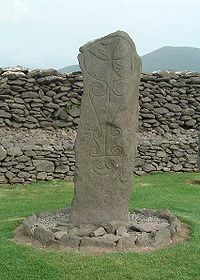
Reask
Encyclopedia

Monasticism
Monasticism is a religious way of life characterized by the practice of renouncing worldly pursuits to fully devote one's self to spiritual work...
located 1 km east of Baile an Fheirtéaraigh
Ballyferriter
Baile an Fheirtéaraigh ), also known as An B[h]uailtín, is a Gaeltacht village in County Kerry, Ireland. It is in the west of the Corca Dhuibhne peninsula and according to the 2002 census, about 75% of the town's population speak the Irish language on a daily basis...
, County Kerry
County Kerry
Kerry means the "people of Ciar" which was the name of the pre-Gaelic tribe who lived in part of the present county. The legendary founder of the tribe was Ciar, son of Fergus mac Róich. In Old Irish "Ciar" meant black or dark brown, and the word continues in use in modern Irish as an adjective...
, Ireland
Republic of Ireland
Ireland , described as the Republic of Ireland , is a sovereign state in Europe occupying approximately five-sixths of the island of the same name. Its capital is Dublin. Ireland, which had a population of 4.58 million in 2011, is a constitutional republic governed as a parliamentary democracy,...
. Although nothing remains of the buildings but low walls and a cross-slab standing stone
Standing stone
Standing stones, orthostats, liths, or more commonly megaliths are solitary stones set vertically in the ground and come in many different varieties....
which sits in the middle of the compound, this site gives a very good idea of the layout of a small monastery of the Early Medieval period.
Excavations by the late Tom Fanning in the 1970s revealed the ruins of an oratory, several clochán
Clochan
A Clochán is a dry-stone hut with a corbelled roof, dating from the early Middle Ages or earlier. Most archaeologists think these structures were built on the southwestern coast of Ireland since the Bronze Age. They are most commonly round beehive huts, but rectangular plans are known as well....
s (stone huts), some conjoined, a graveyard and about ten decorated stone slabs, of which one is a particularly fine example. This pillar measures 1.64 metres in height and is 0.6 metres wide by 0.26 metres thick and is decorated with an encircled Greek cross from which are pendant spiral designs terminating in a pelta. The stone was decorated in Early Christian times (c. 7th century). The letters 'DNE' - D(omi)ne - O Lord, are set sideways to the cross. A second stone is decorated with a large Latin cross coupled with bifurcated terminals and two crosslets in the upper angles. After the oratory was abandoned, the site was used as a ceallurach (children's burial ground) and further burials were made in box-like arrangements of stones, some covered with quartz
Quartz
Quartz is the second-most-abundant mineral in the Earth's continental crust, after feldspar. It is made up of a continuous framework of SiO4 silicon–oxygen tetrahedra, with each oxygen being shared between two tetrahedra, giving an overall formula SiO2. There are many different varieties of quartz,...
and seashore pebbles. The monastic enclosure surrounding these features pre-dates the two groups of double clochans. One of the smaller cross-pillars has a stylised bird. Another has the inscription DNO on one side and DNI on the other.
Some of the artefacts found in the excavation at Reask, including some of the cross-inscribed stones, are on display in Músaem Chorca Dhuibhne, which is in the nearby village of Baile an Fheirtéaraigh.
The site is a National Monument in state care.

Sources
- McNally, Kenneth. "Ireland's Ancient Stones". Belfast: Appletree Press, 2006. ISBN 0 8628 1996 2
- Noonan, Damien. "Castles & Ancient Monuments of Ireland". London: Arum Press, 2001. ISBN 1 8541 0752 6
- Fanning, Thomas. "Excavation of an Early Christian Cemetery and Settlement at Reask, County Kerry, 1981, Proceedings of the Royal Irish Academy Vol.81C, p67-172

